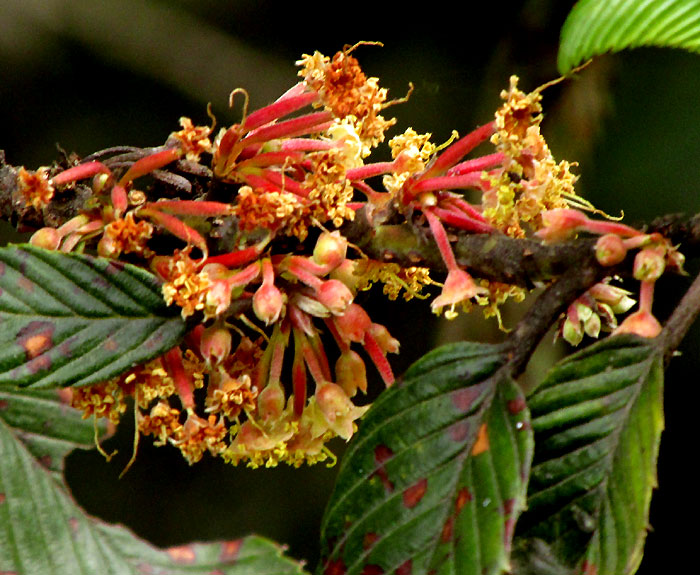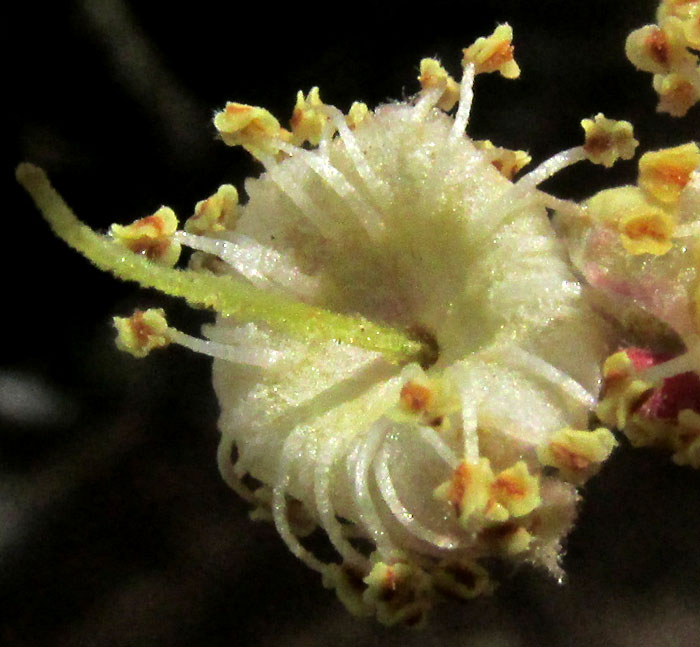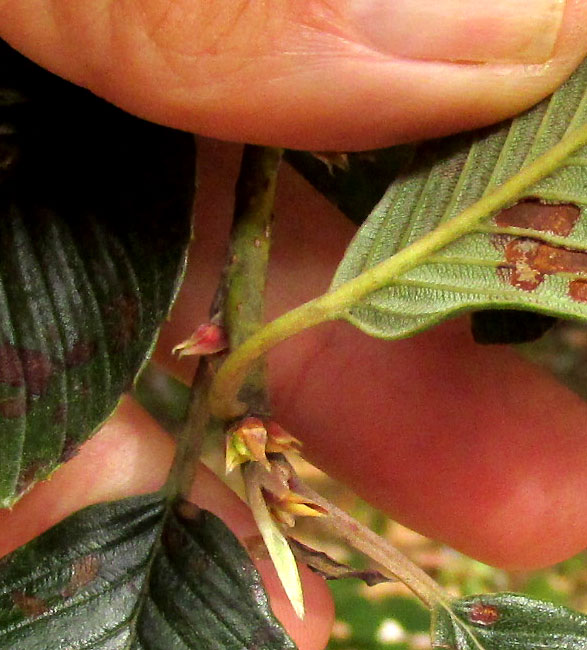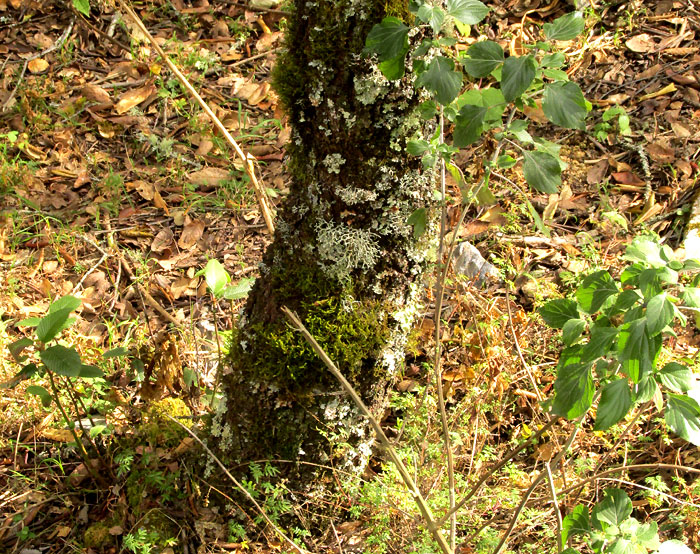Excerpts from Jim Conrad's
Naturalist Newsletter
entry from field notes dated January 19, 2023, taken in disturbed areas and along Hwy 120 on the north and east side of town, elevation ±2,380m (7600 ft); bedrock of Cretaceous limestone, in the Eastern Sierra Madre mountains; walking distance of Pinal de Amoles, Querétaro state, MÉXICO,(N21.137°, W99.622°)
MOUNTAIN MAHOGANY

Beside Hwy 120 about 1km northeast of town, where someone had cleared away most of the underbrush, a tree bore the flowers shown above. The stiff leaves with their shiny tops, many straight veins parallel to one another, and sawtoothed margins, were particularly handsome.

The flowers arose along the stem, several to a bundle, or fascicle, each flower with a sturdy, reddish stem, or pedicel. The blossoms looked a little past their peak flowering time, with many stamens drying and turning brown. It was interesting that some flowers bore long, slender styles, and others not. Also, notice how each flower's pink calyx opens up, the lobes gradually turning white and corolla-like.

A very few flowers were at the stage of development shown above, where about 28 stamens arise from the blossom's white face. The white face is not a corolla, but the expanded calyx; the flower produces no corolla. Notice the greenish style emerging from a hole in the calyx's center. In the previous picture we saw that calyxes expand into broad, cup-like shapes, so the cup-like structure must constrict at the top, where the hole is left for the style's exit. Keeping all that in mind, it's worth looking closer at a blossom from the side:

Apparently the yellow-greenish, cup-like part of the calyx is what's called the hypanthium. Hypanthia are special features in a handful of plant families, so noticing it is important during the identification process. The cup-like hypanthium surrounds the ovary, and often enlarges to surround the fruit, as is the case with rose hips. In fact, when such flowers are seen with so many stamens and a hypanthium, it's very suggestive of the Rose Family, the Rosaceae. However, pomegranate and Crape-Myrtle flowers also bear many stamens and a hypanthium, and they belong to the Loosestrife Family.

The hairless leaves were bicolored, much darker above than below. Conspicuous scale-like stipules arose at the petioles' bases, like in the Rose Family.

The lichen- and moss-covered trunk could have been that of a cherry tree, also a member of the Rose Family.
Having the Rose Family on my mind and looking into that family as represented in the Bajío Region of upland central Mexico, I saw that in this area if you have woody, non-spiny Rose Family member bearing simple leaves with saw-toothed margins, and flowers that are clustered in fascicles, with the flowers themselves not producing petals, you have the genus Cercocarpus, species of which often are known as mountain mahoganies, though they're unrelated. The genus occurs only in western North America and Mexico.
Moreover, in the Bajío Region of upland central Mexico, if you have a Cercocarpus bearing leaves at least 4.5cm long (2.8inch), and the blades display at least 12 pairs of secondary veins, then you have CERCOCARPUS MACROPHYLLUS. Pictures and technical descriptions of that species match our plant.
Cercocarpus macrophyllus is described in the Flora del Bajío as relatively common and sometimes abundant in mountain forests between 1750 and 3100m (5700-10,200ft). It's endemic just to the forested uplands of Mexico, south to Oaxaca.
Maybe the most striking feature of the species -- typical of the genus Cercocarpus -- is its feathery fruits. The slender style seen above emerging through the hole of the constricted hypanthium drastically enlarges, until it looks like a very slender, twisted feather. A cluster of mature fruits looks like a bunch of clematis fruits. Both Cercocarpus and clematis vines produce dry, one-seeded, none-splitting achene-type fruits. In fact, the genus name is derived from the classical Greek kerkos meaning "tail" and karpos meaning "fruit," so the genus name describes this interesting "tailed fruit."
The online Flora Medicinal Indígena de México reports that in Durango the tree's bark is boiled and the resulting tea is drunk while fasting to enrich the blood, something needed when one feels weak. The "mahogany" in the genus's English name is based on the hard, very dense and fine-textured, reddish-brown heartwood, which darkens with age, reminiscent of mahogany wood. However, the species are too small and the wood too hard to work to be harvested for timber. Local people cut it for firewood.
Entry dated April 19, 2024, from notes taken about 1.5km northeast of Puerto de los Velazquez, Municipality of Pinal de Amoles; N21.138°, W99.665°, elevation ~2780 meters (~9120 feet); oak/pine forest on limestone bedrock; in the Eastern Sierra Madre Mountains of east-central Querétaro state, MÉXICO
MOUNTAIN MAHOGANY IN FRUIT

On the north side of a ridge with billows of cloud-mist rushing upslope around us, a small tree seemed to have gathered messes of white shredded plastic or wet toilet paper at its branch tips.

Up close, the handsome leaves and a closer look at the whiteness showed that we had a Mountain Mahogany loaded with remarkable, one-seeded, achene-type fruits.

Above, the fruit's white, feathery part displayed what the original flower's style had turned into. An average style is a short, neck-like connections between the top of an ovary and the pollen-receiving stigma, and typically styles disappear as the fruits mature. In the genus Cercocarpus, the styles not only remain but enlarge enormously, with the white projections along its sides expanding with it. In the above picture, from the same stem tip from which the white, feathery, mature fruit arises, a much less mature fruit has begun forming. Note how a feather tuft at the immature fruit's tip surrounds the style at the very beginning of its elongation process.
Referring to various mountain mahogany species, G.H. Deitschman and others in the US Forest Service's 1974 Seeds of woody plants in the United States. Agricultural Handbook 450, says that abundant fruit production occurs at 1- to 10-year intervals. This may explain why I've never before seen such a spectacular mountain mahogany crop of fruits as this.
I wouldn't be surprised if the timing of this crop is influenced by this area's ongoing weather pattern which the North American Drought Monitor characterizes as the droughtiest of its drought categories, a D4 Drought.